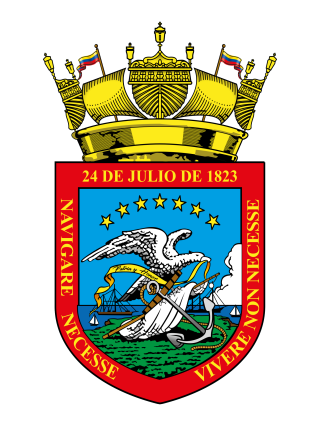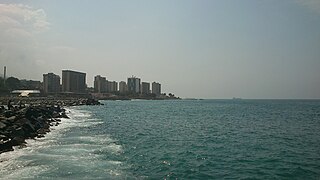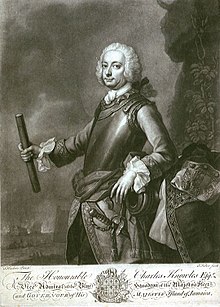
The War of Jenkins' Ear, or Guerra del Asiento, was a conflict lasting from 1739 to 1748 between Britain and Spain. The majority of the fighting took place in New Granada and the Caribbean Sea, with major operations largely ended by 1742. It was related to the 1740 to 1748 War of the Austrian Succession. The name was coined in 1858 by British historian Thomas Carlyle, and refers to Robert Jenkins, captain of the British brig Rebecca, whose ear was allegedly severed by Spanish coast guards while searching his ship for contraband in April 1731.
Four ships of the Royal Navy have been named HMS Hermione after Hermione, the daughter of Menelaus and Helen in Greek mythology.

The Bolivarian Navy of Venezuela, commonly known as the Venezuelan Navy, is the naval branch of the National Bolivarian Armed Forces of Venezuela.

La Guaira is the capital city of the Venezuelan state of the same name and the country's main port. It was founded in 1577 as an outlet for Caracas, 30 kilometres (19 mi) to the southeast. The town and the port were badly damaged during the December 1999 floods and mudslides that affected much of the region.

Admiral of the Fleet Sir Chaloner Ogle KB was a Royal Navy officer and politician. After serving as a junior officer during the Nine Years' War, a ship he was commanding was captured by three French ships off Ostend in July 1706 in an action during the War of the Spanish Succession. Ogle was given command of the fourth-rate HMS Swallow and saw action against the pirate fleet of Bartholomew Roberts in the Battle of Cape Lopez in February 1722. The action was to prove a turning point in the war against the pirates and many consider the death of Roberts to mark the end of the Golden Age of Piracy.

HMS Suffolk was a 70-gun third-rate ship of the line of the Royal Navy, built by contract of 20 February 1678 by Sir Henry Johnson at Blackwall. She participated in the War of the English Succession 1689 - 1697, in the Battles of Beachy Head and Barfleur. She was rebuilt in 1699. She was actively involved in the War of Spanish Succession 1702 - 1713. Her later career was as guard ship duties, deployments to the Baltic Sea and the West Indies. She was finally broken in 1765 after lying in Ordinary for almost twenty years.
HMS Norwich was a 50-gun fourth rate ship of the line of the Royal Navy, launched at Deptford on 24 August 1693.

HMS Burford was a 70-gun third rate ship of the line of the Royal Navy, built at Deptford Dockyard to the 1719 Establishment, and launched on 19 July 1722. Burford was notably the early posting of both John Forbes and John Byng, both of whom rose to become Admirals.

Sir Charles Knowles, 1st Baronet was a British naval officer who served in the Royal Navy, seeing service during the War of Jenkins' Ear, the wider War of the Austrian Succession, and the Seven Years' War. He also briefly served under the Imperial Russian Navy during the Russo-Turkish War. He rose to the rank of Admiral in a long and varied career, crowned with both success, and at times, controversy.
Hugh Pigot was an officer in the Royal Navy. Through his connections and their patronage, he was able to rise to the rank of captain, despite apparently poor leadership skills and a reputation for brutality. While he was captain of Hermione, he eventually provoked his men to mutiny. The mutiny, which became one of the bloodiest in the history of the Royal Navy, left Pigot and nine other officers dead. The Navy hunted down and executed a number of the mutineers and recaptured his ship from the Spanish, to whom the mutineers had turned it over.
The Battle of Puerto Cabello was a failed attack on a Spanish colonial port during the War of Jenkins' Ear on 16 April 1743.

The Battle of La Guaira was a naval engagement fought in the Caribbean Sea on 11 December 1812 during the war between Britain and the United States. An American privateer captured a British letter of marque at the Spanish port of La Guaira in Venezuela.

Lord Augustus FitzRoy was a British officer of the Royal Navy. He served during the War of the Austrian Succession, and was involved in the capture of the Spanish ship of the line, Princesa, a major prize in the war. He was also the father of Augustus FitzRoy, 3rd Duke of Grafton, who became Prime Minister of Great Britain.

Jose Antonio Arizabalo Orobio was a Spanish military, born in Guipúzcoa, still a child at the age of seven he moved with his family to Venezuela, and played an important role in the Spanish American wars of independence.

The Cutting out of the Hermione, or Capture of Hermione, was a naval action that took place at Puerto Cabello, Venezuela on 25 October 1799. The formerly British frigate HMS Hermione, which had been handed over to the Spanish by its crew following a vicious mutiny, lay in the heavily guarded sea port of Puerto Cabello, now under the command of Don Ramón de Chalas.

San Felipe Castle is an eighteenth-century star fort protecting Puerto Cabello in Venezuela. It was named in honour of Philip V, King of Spain at the time of its construction in the 1730s. It has an alternative name Castillo Libertador, explained by its connection with Simón Bolívar, known as El Libertador because of his role in Latin American independence.
The 2018 Primera División season, officially Liga de Fútbol Profesional Venezolano or Liga FUTVE, was the 37th professional season of Venezuela's top-flight football league. Monagas were the defending champions, but did not qualify to the Serie Final, after being eliminated in the regular season of the Torneo Apertura and by Caracas in the quarter-finals of the Torneo Clausura.
The 2019 Copa Venezuela was the 50th edition of the competition. It began on 27 July 2019 with the first stage and concluded on 27 November 2019 with the second leg of the finals. The champions will qualify for the 2020 Copa Sudamericana. Primera División side Zulia were the defending champions, but they were eliminated by Academia Puerto Cabello in the quarter-finals.
Alfarabi José Romero Romero is a Venezuelan football manager and former player who played as a defender. He is the current manager of Marítimo de La Guaira.














